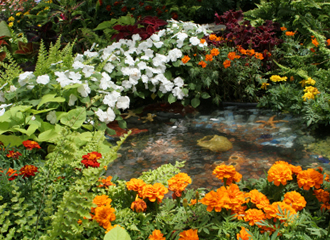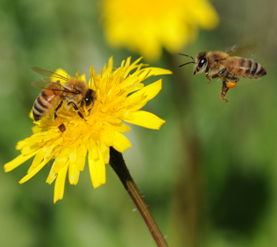
General tasks and garden maintenance
Beware late frosts and keep vulnerable plants and new shoots protected at night if frost is forecast. Don’t be tempted to put out tender bedding until much later on in the month and even then be prepared to cover it if necessary.
Deadhead daffodils and narcissi, give them a liquid feed or sprinkling of bonemeal and then let them die down. Don’t cut off the leaves as they are necessary to replenish the bulb for next year. Keep deadheading spring bedding to keep it looking neat and encourage new flowers.
Continue with the spring cleaning. Hoe your borders, getting rid of weeds before they take hold - annual weeds such as bitter cress and groundsel are enough of a nightmare without allowing them to go forth and multiply by seeding. If it’s dry, attack ground elder and the like with systemic weed killer painted onto the leaves. Mulch away while you can still see what you are doing and before the herbaceous growth really takes off.
Use your own garden compost or leaf mould, well rotted manure, the contents of out-of-date grow bags or ready-made soil conditioner.
Now the soil is warming up and things are starting to grow, add general purpose fertiliser before covering with mulch especially in borders, the fruit and vegetable patch and containers. If you have already mulched, draw it back (if possible), tease the soil a little, add fertiliser and replace the mulch.
Carry on removing moss and weeds from paths, terraces and drives.
Make new beds and borders - mark the shape with sand trickled from a bottle, remove the top layer of growing vegetation and dig the ground over, incorporating as much organic matter as possible.
If you are making a bed in the lawn, remove the turf – if you dig it in the buried grass will regrow and regrow and regrow and...
Clean and repair your garden tools, book the lawn mower in for a service and check garden furniture for any rot. When it is warm enough, treat sheds, fences and trellis with wood preservative; brushes and rollers are fine for most things, however a sprayer is well worth buying for tricky projects such as woven panels!
Now is the time to wage war on slugs and snails!!
They love tulips and delicacies such as the delicious young shoots of delphiniums and the like, so use pet-friendly slug pellets, drench the ground around hostas with liquid slug killer to exterminate slugs below the surface. Keep an eye out for snails and pick them off - what you do with them is up to you. Birds are your friends here - flat stones artfully located are useful accessories for birds to practise their snail bashing techniques.
Birds

Birds will be building their nests now in preparation for laying their eggs.
Do keep putting out bird food - they quickly become accustomed to regular food supplies and it’s a real treat to see wild birds in the garden.
To encourage our feathered friends, use bird houses and feeding stations great for amateur and avid bird watchers alike.
Lawns

Most lawns are looking a far cry from the emerald swards of last year. Unless the weather stays filthy and cold in which case it is better to wait for balmier days, feed with a spring lawn feed to encourage new growth (these have a high nitrogen content to encourage leaf growth),
Mow regularly (start with the blades high for the first couple of cuts), overseed bare patches and apply weed and moss killer.
Rake out or scarify AFTER applying moss killer or you will merely be spreading moss to the rest of your lawn!
Now is the ideal time to sow new lawns on well prepared ground.
Trees, shrubs and climbers

Plant and move evergreen shrubs, conifers and trees and remember to water them well until firmly rooted in. Plant evergreen hedges such as laurel, yew and box and again keep them well watered in dry spells. A good soak once a week is better than superficial watering on a regular basis.
Feed woody plants with general purpose fertiliser - this applies to roses, trees, climbers, hedges and shrubs.
Feed acid loving plants such as camellias and rhododendrons with ericaceous feed if you are on neutral or alkaline soil. A dose of sequestered iron also helps prevent the leaves turning yellow.
(Tip - mulch regularly with fresh or composted pine needles. This can acidify the ground slightly.)
Finish pruning your roses and start spraying them with fungicide to ward against black spot and mildew. Repeat every fortnight until the autumn. Remember that if an infection sets it, all the stricken leaves must be burnt - do not leave them on the compost heap as this will become the perfect incubation site.
Prune hydrangeas - do not remove stems with a bud at the top, but snip off old stems bearing deadheads to just above the topmost healthy bud and remove weak shoots altogether from the base.
With established plants, remove some of the older shoots right down to the base - this will keep the plant compact. The latter also applies to forsythia (prune once it has finished flowering by cutting back flowered shoots down to a new shoot further down - all the new growth this season will flower next year) and to flowering currants (Ribes).












